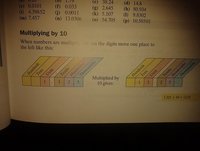Probability
Full Member
- Joined
- Jan 26, 2012
- Messages
- 432
Suppose I have a number 0.082 and I multiply it by 100. The number 0.082 moves two places to the left and reads; 8.2
Suppose then that same number is presented like this; [MATH](8.2\times10^-2)[/MATH]
If then this number is multiplied by [MATH](10^-2)[/MATH] it should read 0.082
Because the power is a negative the number goes smaller when multiplied.
Now look at this example;
Calculate with scientific notation;
[MATH](8.2\times(10^-2)-(5.4\times(10^-3)[/MATH]
If I now multiply [MATH](8.2)\times(10^-2)=(82)\times(10)\times(10^-3)=(82\times(10^-3)[/MATH]
I'm a little confused at this point because the decimal place has only moved 1 position, yet I'd of thought multiplying by [MATH](10^-2)[/MATH] would have moved 2 decimal places!
Before I move on would somebody please explain what I am not understanding.
Suppose then that same number is presented like this; [MATH](8.2\times10^-2)[/MATH]
If then this number is multiplied by [MATH](10^-2)[/MATH] it should read 0.082
Because the power is a negative the number goes smaller when multiplied.
Now look at this example;
Calculate with scientific notation;
[MATH](8.2\times(10^-2)-(5.4\times(10^-3)[/MATH]
If I now multiply [MATH](8.2)\times(10^-2)=(82)\times(10)\times(10^-3)=(82\times(10^-3)[/MATH]
I'm a little confused at this point because the decimal place has only moved 1 position, yet I'd of thought multiplying by [MATH](10^-2)[/MATH] would have moved 2 decimal places!
Before I move on would somebody please explain what I am not understanding.

